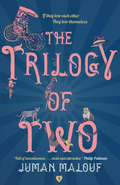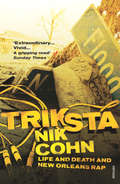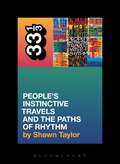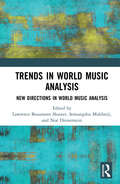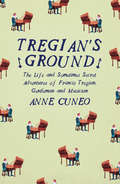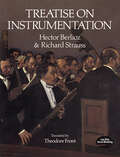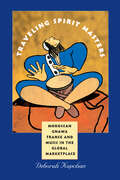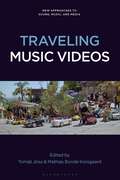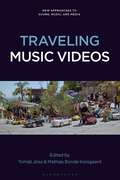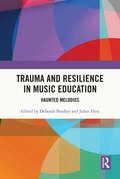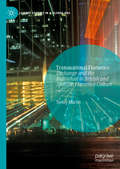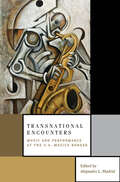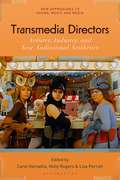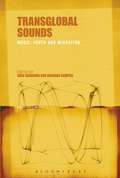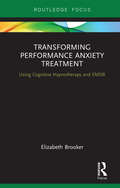- Table View
- List View
Trinity Grade 1 Theory Past Papers 2019
by Trinity College London PressTrinity Grade 1 Theory Past Papers 2019
Trinity Grade 1 Theory Model Answers 2019
by Trinity College London PressTrinity Grade 1 Theory Model Answers 2019
The Trilogy of Two
by Juman MaloufA highly original and acclaimed fantasy novel with eccentric characters, striking illustrations and a propulsive plot"[A] spellbinder"The Daily Beast"A sweeping tale. . . gorgeous illustrations"PopSugarIdentical twins Sonja and Charlotte, twelve-year-old musical prodigies, learned to play before they learned to talk. They were born on All-Hallows-Eve and found one night by Tatty, the Tattooed Lady, in a pail on her doorstep with only a short note and a heart-shaped locket. They have been with her ever since, roaming the Outskirts with the circus company in a convoy of caravans, moving from place to place.Lately, mysterious things have begun to happen when the girls pick up their instruments. Movements, vibrations, changes in the weather. They begin to discover that they possess extraordinary powers. During one of their performances, they unintentionally levitate the entire audience—and word gets out. Soon, a troop of Enforcers from the city comes after them, and Charlotte and Sonja must embark on a perilous journey through enchanted lands in hopes of unlocking the secrets of their mysterious past.Juman Malouf, born in Lebanon, grew up in London. She has an MFA in set and costume design and has worked on a number of films including Wes Anderson's Moonrise Kingdom and The Grand Budapest Hotel. The Trilogy of Two is her first novel.
Triksta: Life and Death and New Orleans Rap
by Nik CohnWhat lunacy would cause a 55-year-old white male to embroil himself in the world of New Orleans rap - as ideas man, talent-spotter, lyricist, and would-be producer? Nik Cohn has loved (and hated) hip-hop since its birth and loved (and hated) New Orleans for even longer - an addiction he's never wanted to kick. But nothing prepared him for the experience of being pitched, more or less by accident, into the role of Triksta, rap impresario. A white alien in a black world, with no funding or qualifications, and not a clue what he was doing, he had to rethink himself from scratch. Surrounded by a cast that included such names as Choppa and Soulja Slim, Big Ramp and Lil T, Bass Heavy, Fifth Ward Weebie, and Shorty Brown Hustle, he entered a world of tiny backstreet studios, broken-down slums and gun turfs.Triksta is the story of a three-year odyssey to the heart of rap, and New Orleans, and self-knowledge.
A Tribe Called Quest's People's Instinctive Travels and the Paths of Rhythm (33 1/3)
by Shawn TaylorOne of the finest hip-hop albums ever made, A Tribe Called Quest's debut record (featuring stone-cold classics like "Can I Kick It?" and "Bonita Applebum") took the idea of the boasting hip-hop male and turned it on its head. For many listeners, when this non-traditional, surprisingly feminine album was released, it was like hearing an entirely new form of music. In this book, Shawn Taylor explores the creation of the album as well as the impact it had on him at the time - a 17-year-old high-school geek who was equally into hip-hop, punk, new wave, skateboarding, and Dungeons & Dragons: all of a sudden, with this one album, the world made more sense. He has spent many years investigating this album, from the packaging to the song placement to each and every sample - Shawn Taylor knows this record like he knows his tattoos, and he's finally been able to write a fascinating and highly entertaining book about it.
A Tribe Called Quest's People's Instinctive Travels and the Paths of Rhythm (33 1/3)
by Shawn TaylorOne of the finest hip-hop albums ever made, A Tribe Called Quest's debut record (featuring stone-cold classics like "Can I Kick It?" and "Bonita Applebum") took the idea of the boasting hip-hop male and turned it on its head. For many listeners, when this non-traditional, surprisingly feminine album was released, it was like hearing an entirely new form of music. In this book, Shawn Taylor explores the creation of the album as well as the impact it had on him at the time - a 17-year-old high-school geek who was equally into hip-hop, punk, new wave, skateboarding, and Dungeons & Dragons: all of a sudden, with this one album, the world made more sense. He has spent many years investigating this album, from the packaging to the song placement to each and every sample - Shawn Taylor knows this record like he knows his tattoos, and he's finally been able to write a fascinating and highly entertaining book about it.
Trends in World Music Analysis: New Directions in World Music Analysis
by Lawrence Beaumont ShusterThis volume brings together a group of analytical chapters exploring traditional genres and styles of world music, capturing a vibrant and expanding field of research. These contributors, drawn from the forefront of researchers in world music analysis, seek to break down barriers and build bridges between scholarly disciplines, musical repertoires, and cultural traditions. Covering a wide range of genres, styles, and performers, the chapters bring to bear a variety of methodologies, including indigenous theoretical perspectives, Western music theory, and interdisciplinary techniques rooted in the cognitive and computational sciences. With contributors addressing music traditions from Africa, Asia, Europe, and the Americas, this volume captures the many current directions in the analysis of world music, offering a state of the fi eld and demonstrating the expansion of possibilities created by this area of research.
Trends in World Music Analysis: New Directions in World Music Analysis
by Lawrence Beaumont Shuster Somangshu Mukherji Noé DinnersteinThis volume brings together a group of analytical chapters exploring traditional genres and styles of world music, capturing a vibrant and expanding field of research. These contributors, drawn from the forefront of researchers in world music analysis, seek to break down barriers and build bridges between scholarly disciplines, musical repertoires, and cultural traditions. Covering a wide range of genres, styles, and performers, the chapters bring to bear a variety of methodologies, including indigenous theoretical perspectives, Western music theory, and interdisciplinary techniques rooted in the cognitive and computational sciences. With contributors addressing music traditions from Africa, Asia, Europe, and the Americas, this volume captures the many current directions in the analysis of world music, offering a state of the fi eld and demonstrating the expansion of possibilities created by this area of research.
Tregian's Ground: The Life and Sometimes Secret Adventures of Francis Tregian, Gentleman and Musician
by Anne CuneoThe significance of the Fitzwilliam Virginal Book to our musical canon is well known; the remarkable story of its copyist and compiler, Francis Tregian, less so. Born into Cornish Catholic nobility and plumb into the choppy waters of the Elizabethan Age, he must rely on his surpassing skill as a musician to survive.In this Prix des Libraires (Booksellers Prize) winning novel, Anne Cuneo deftly recreates the musician’s journey across Renaissance Europe, which sees him befriending Shakespeare, swapping partitions with William Byrd and Monteverdi, and playing in the court of Henri IV of France.The result is as gripping as it is authentic: an epic, transcontinental choreography in which Europe’s monarchs tussle with pretenders to their thrones, and ordinary people steer between allegiances to God, nation and family.Complete with links to live performances and to recordings of selected musical sources in the Tregian's Ground Discography.
Treatise on Instrumentation
by Hector Berlioz Richard StraussThe most influential work of its kind ever written, appraising the musical qualities and potential of over 60 commonly used stringed, wind and percussion instruments. With 150 illustrative full-score musical examples from works by Berlioz, Mozart, Beethoven, Gluck, Weber, Wagner, and others, and numerous smaller musical examples. Complete with Berlioz' chapters on the orchestra and on conducting. Translated by Theodore Front. Foreword by Richard Strauss. Glossary.
Traveling Spirit Masters: Moroccan Gnawa Trance and Music in the Global Marketplace (Music / Culture)
by Deborah KapchanA group of ritual musicians and former slaves brought from sub-Saharan Africa to Morocco, the Gnawa heal those they believe to be possessed, using incense, music, and trance. But their practice is hardly of only local interest: the Gnawa have long participated in the world music market through collaborations with African-American jazz musicians and French recording artists. In this first book in English on Gnawa music and its global reach, author Deborah Kapchan explores how these collaborations transfigure racial and musical identities on both sides of the Atlantic. She also addresses how aesthetic styles associated with the sacred come to inhabit non-sacred contexts, and what new amalgams they produce. Her narrative details the fascinating intrinsic properties of trance, including details of enactment, the role of gesture and the body, and the use of the senses, and how they both construct authentic Gnawa identity and reconstruct historically determined relations of power. Traveling Spirit Masters is a captivating and elucidating demonstration of how and why trance—and indeed all sacred music—is fast becoming a transnational sensation.
Traveling Music Videos (New Approaches to Sound, Music, and Media)
by Tomáš Jirsa and Mathias Bonde KorsgaardTraveling Music Videos offers a new interdisciplinary perspective on how contemporary music videos travel across, shape, and transform various media, online platforms, art institutions, and cultural industries worldwide. With the onset of digital technologies and the proliferation of global video-sharing websites at the beginning of the 21st century, music video migrated from TV screens to turn instead to the internet, galleries, concert stages, and social media. As a result, its aesthetics, technological groundings, and politics have been radically transformed. From the kinaesthetic experience of TikTok to the recent reimaginations of maps and navigation tools through music video cartographies, from the ecofeminist voices mediated by live-stream concerts to the transmedia logic of video games and VR, from the videos' role in contemporary art galleries to their political interventions -the chapters map the ways music video is continually reconfiguring itself. The volume tracks music video's audiovisual itineraries across different geographies, maps its transmedia routes, and tackles the cultural impact that it has on our current media ecosystem.
Traveling Music Videos (New Approaches to Sound, Music, and Media)
Traveling Music Videos offers a new interdisciplinary perspective on how contemporary music videos travel across, shape, and transform various media, online platforms, art institutions, and cultural industries worldwide. With the onset of digital technologies and the proliferation of global video-sharing websites at the beginning of the 21st century, music video migrated from TV screens to turn instead to the internet, galleries, concert stages, and social media. As a result, its aesthetics, technological groundings, and politics have been radically transformed. From the kinaesthetic experience of TikTok to the recent reimaginations of maps and navigation tools through music video cartographies, from the ecofeminist voices mediated by live-stream concerts to the transmedia logic of video games and VR, from the videos' role in contemporary art galleries to their political interventions -the chapters map the ways music video is continually reconfiguring itself. The volume tracks music video's audiovisual itineraries across different geographies, maps its transmedia routes, and tackles the cultural impact that it has on our current media ecosystem.
Trauma and Resilience in Music Education: Haunted Melodies
by Juliet Hess Deborah BradleyTrauma and Resilience in Music Education: Haunted Melodies considers the effects of trauma on both teachers and students in the music class- room, exploring music as a means for working through traumatic expe- riences and the role music education plays in trauma studies. The volume acknowledges the ubiquity of trauma in our society and its long-term deleterious effects while showcasing the singular ways music can serve as a support for those who struggle. In twelve contributed essays, authors examine theoretical perspectives and personal and societal traumas, providing a foundation for thinking about their implications in music education. Topics covered include: Philosophical, psychological, sociological, empirical, and narrative perspectives of trauma and resilience. How trauma-informed education practices might provide guidelines for music educators in schools and other settings Interrogations of how music and music education may be a source of trauma Distinguishing itself from other subjects—even the other arts—music may provide clues to the recovery of traumatic memory and act as a tool for releasing emotions and calming stresses. Trauma and Resilience in Music Education witnesses music’s unique abilities to reach people of all ages and empower them to process traumatic experiences, providing a vital resource for music educators and researchers.
Trauma and Resilience in Music Education: Haunted Melodies
by Juliet Hess Deborah BradleyTrauma and Resilience in Music Education: Haunted Melodies considers the effects of trauma on both teachers and students in the music class- room, exploring music as a means for working through traumatic expe- riences and the role music education plays in trauma studies. The volume acknowledges the ubiquity of trauma in our society and its long-term deleterious effects while showcasing the singular ways music can serve as a support for those who struggle. In twelve contributed essays, authors examine theoretical perspectives and personal and societal traumas, providing a foundation for thinking about their implications in music education. Topics covered include: Philosophical, psychological, sociological, empirical, and narrative perspectives of trauma and resilience. How trauma-informed education practices might provide guidelines for music educators in schools and other settings Interrogations of how music and music education may be a source of trauma Distinguishing itself from other subjects—even the other arts—music may provide clues to the recovery of traumatic memory and act as a tool for releasing emotions and calming stresses. Trauma and Resilience in Music Education witnesses music’s unique abilities to reach people of all ages and empower them to process traumatic experiences, providing a vital resource for music educators and researchers.
Transpositions: Migration, Translation, Music (Contemporary French and Francophone Cultures #79)
This publication benefited from the support of the Institute for Scholarship in the Liberal Arts at the University of Notre Dame.This collective volume concentrates on the concept of transposition, exploring its potential as a lens through which to examine recent Francophone literary, cinematic, theatrical, musical, and artistic creations that reveal multilingual and multicultural realities. The chapters are composed by leading scholars in French and Francophone Studies who engage in interdisciplinary reflections on the ways transcontinental movement has influenced diverse genres. It begins with the premise that an attentiveness to migration has inspired writers, artists, filmmakers, playwrights and musicians to engage in new forms of translation in their work. Their own diverse backgrounds combine with their awareness of the itineraries of others to have an impact on the innovative languages that emerge in their creative production. These contemporary figures realize that migratory actualities must be transposed into different linguistic and cultural contexts in order to be legible and audible, in order to be perceptible—either for the reader, the listener, or the viewer. The novels, films, plays, works of art and musical pieces that exemplify such transpositions adopt inventive elements that push the limits of formal composition in French. This work is therefore often inspiring as it points in evocative ways toward fluid influences and a plurality of interactions that render impossible any static conception of being or belonging.
Transnational Flamenco: Exchange and the Individual in British and Spanish Flamenco Culture (Leisure Studies in a Global Era)
by Tenley MartinThis book provides insight into how flamenco travels, the forms it assumes in new locales, and the reciprocal effects on the original scene. Utilising a postnational approach to cultural identity, Martin explores the role of non-native culture brokers in cultural transmission. This concept, referred to as ‘cosmopolitan human hubs’, builds on Kiwan and Meinhof’s ‘hubs’ theory of network migration to move cultural migration and globalisation studies forwards. Martin outlines a post-globalisation flamenco culture through analysis of ethnographic research carried out in the UK, Sevilla and Madrid. Insight into these glocal scenes characterises flamenco as a historically globalized art complex, represented in various hubs around the world. This alternative approach to music migration and globalisation studies will be of interest to students and scholars across leisure studies, musicology, sociology and anthropology.
Transnational Encounters: Music and Performance at the U.S.-Mexico Border
by Alejandro L. MadridThrough the study of a large variety of musical practices from the U.S.-Mexico border, Transnational Encounters seeks to provide a new perspective on the complex character of this geographic area. By focusing not only on norteña, banda or conjunto musics (the most stereotypical musical traditions among Hispanics in the area) but also engaging a number of musical practices that have often been neglected in the study of this border's history and culture (indigenous musics, African American musical traditions, pop musics), the authors provide a glance into the diversity of ethnic groups that have encountered each other throughout the area's history. Against common misconceptions about the U.S.-Mexico border as a predominant Mexican area, this book argues that it is diversity and not homogeneity which characterizes it. From a wide variety of disciplinary and multidisciplinary enunciations, these essays explore the transnational connections that inform these musical cultures while keeping an eye on their powerful local significance, in an attempt to redefine notions like "border," "nation," "migration," "diaspora," etc. Looking at music and its performative power through the looking glass of cultural criticism allows this book to contribute to larger intellectual concerns and help redefine the field of U.S.-Mexico border studies beyond the North/South and American/Mexican dichotomies. Furthermore, the essays in this book problematize some of the widespread misconceptions about U.S.-Mexico border history and culture in the current debate about immigration.
Transmedia Directors: Artistry, Industry and New Audiovisual Aesthetics (New Approaches to Sound, Music, and Media)
by CarolHollyLisa Vernallis Rogers PerrottTransmedia Directors focuses on artist-practitioners who work across media, platforms and disciplines, including film, television, music video, commercials and the internet. Working in the age of media convergence, today's em/impresarios project a distinctive style that points toward a new contemporary aesthetics. The media they engage with enrich their practices – through film and television (with its potential for world-building and sense of the past and future), music video (with its audiovisual aesthetics and rhythm), commercials (with their ability to project a message quickly) and the internet (with its refreshed concepts of audience and participation), to larger forms like restaurants and amusement parks (with their materiality alongside today's digital aesthetics). These directors encourage us to reassess concepts of authorship, assemblage, transmedia, audiovisual aesthetics and world-building. Providing a vital resource for scholars and practitioners, this collection weaves together insights about artist-practitioners' collaborative processes as well as strategies for composition, representation, subversion and resistance.
Transmedia Directors: Artistry, Industry and New Audiovisual Aesthetics (New Approaches to Sound, Music, and Media)
Transmedia Directors focuses on artist-practitioners who work across media, platforms and disciplines, including film, television, music video, commercials and the internet. Working in the age of media convergence, today's em/impresarios project a distinctive style that points toward a new contemporary aesthetics. The media they engage with enrich their practices – through film and television (with its potential for world-building and sense of the past and future), music video (with its audiovisual aesthetics and rhythm), commercials (with their ability to project a message quickly) and the internet (with its refreshed concepts of audience and participation), to larger forms like restaurants and amusement parks (with their materiality alongside today's digital aesthetics). These directors encourage us to reassess concepts of authorship, assemblage, transmedia, audiovisual aesthetics and world-building. Providing a vital resource for scholars and practitioners, this collection weaves together insights about artist-practitioners' collaborative processes as well as strategies for composition, representation, subversion and resistance.
Transglobal Sounds: Music, Youth and Migration
by João Sardinha Ricardo CamposThrough a transnational, comparative and multi-level approach to the relationship between youth, migration, and music, the aesthetic intersections between the local and the global, and between agency and identity, are presented through case studies in this book. Transglobal Sounds contemplates migrant youth and the impact of music in diaspora settings and on the lives of individuals and collectives, engaging with broader questions of how new modes of identification are born out of the social, cultural, historical and political interfaces between youth, migration and music. Thus, through acts of mobility and environments lived in and in-between, this volume seeks to articulate between musical transnationalism and sense of place in exploring the complex relationship between music and young migrants and migrant descendant's everyday lives.
Transglobal Sounds: Music, Youth and Migration
by João Sardinha Ricardo CamposThrough a transnational, comparative and multi-level approach to the relationship between youth, migration, and music, the aesthetic intersections between the local and the global, and between agency and identity, are presented through case studies in this book. Transglobal Sounds contemplates migrant youth and the impact of music in diaspora settings and on the lives of individuals and collectives, engaging with broader questions of how new modes of identification are born out of the social, cultural, historical and political interfaces between youth, migration and music. Thus, through acts of mobility and environments lived in and in-between, this volume seeks to articulate between musical transnationalism and sense of place in exploring the complex relationship between music and young migrants and migrant descendant's everyday lives.
Transforming Performance Anxiety Treatment: Using Cognitive Hypnotherapy and EMDR (Routledge Focus on Mental Health)
by Elizabeth BrookerTransforming Performance Anxiety Treatment: Using Cognitive Hypnotherapy and EMDR offers a much needed and different approach to this issue, using two psychodynamic therapies which work to bring about rapid and long-lasting change. Using nine reflexive case studies, the author examines two little used interventions, cognitive hypnotherapy (CH) and eye movement desensitisation and reprocessing (EMDR). The basic theories of cognitive anxiety and the emotions that underpin this condition are explored. The principles and protocols of CH and EMDR are explained, and how these psychodynamic therapies are adapted to effect permanent change. The first book to examine these treatments for this condition, Transforming Performance Anxiety Treatment will be of interest for practitioners and therapists in training, as well as educators, professionals, and therapists working within competitive sports.

